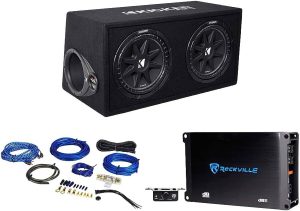Car audio enthusiasts know that a powerful sound system can transform any drive into an immersive experience. However, achieving crisp, high-quality audio requires more than just premium speakers and amplifiers. One often-overlooked component plays a critical role in ensuring your car audio system performs at its peak: the car audio voltage regulator. This device stabilizes the electrical supply, protects your equipment, and enhances sound quality. In this comprehensive guide, we’ll dive deep into what a car audio voltage regulator is, why it matters, how it works, and how to choose the right one for your setup. By the end, you’ll have all the knowledge needed to elevate your car’s audio game.
Contents
- What Is a Car Audio Voltage Regulator?
- Why Your Car Audio System Needs a Voltage Regulator
- How Does a Car Audio Voltage Regulator Work?
- Types of Car Audio Voltage Regulators
- Key Features to Look for in a Car Audio Voltage Regulator
- How to Install a Car Audio Voltage Regulator
- Top Benefits of Using a Car Audio Voltage Regulator
- Common Mistakes to Avoid When Using a Voltage Regulator
- How to Choose the Best Car Audio Voltage Regulator for Your Needs
- Popular Brands of Car Audio Voltage Regulators
- Maintaining Your Car Audio Voltage Regulator
- Frequently Asked Questions About Car Audio Voltage Regulators
- Conclusion: Elevate Your Car Audio Experience with a Voltage Regulator
What Is a Car Audio Voltage Regulator?
A car audio voltage regulator is a device that maintains a consistent voltage supply to your car’s audio system. Car electrical systems are prone to fluctuations due to the demands of various components like air conditioning, headlights, and the audio system itself. These fluctuations can cause voltage drops, leading to distorted sound, reduced amplifier performance, or even damage to sensitive audio equipment. A voltage regulator steps in to deliver a steady, clean power supply, ensuring your audio system operates smoothly.
Think of it like a gatekeeper for your car’s electrical system. It filters out inconsistencies and provides a reliable power flow, allowing your amplifiers, subwoofers, and speakers to perform at their best. Whether you’re blasting bass-heavy tracks or enjoying crystal-clear vocals, a voltage regulator ensures your system doesn’t miss a beat.
Why Your Car Audio System Needs a Voltage Regulator
You might wonder if a voltage regulator is truly necessary for your setup. After all, your car’s battery and alternator already supply power, right? While that’s true, these components aren’t designed to handle the intense power demands of high-end car audio systems. Let’s explore the key reasons why a voltage regulator is a game-changer for your audio setup.
1. Prevents Voltage Drops
High-powered amplifiers and subwoofers draw significant amounts of current, especially during bass-heavy tracks. This can cause voltage drops in your car’s electrical system, leading to dimming headlights, reduced audio output, or even system shutdowns. A voltage regulator stabilizes the power supply, ensuring your audio system gets the consistent voltage it needs to perform.
2. Protects Your Equipment
Fluctuating voltage can wreak havoc on sensitive audio components. Sudden spikes or drops may damage amplifiers, speakers, or processors, leading to costly repairs or replacements. A voltage regulator acts as a shield, safeguarding your investment and extending the lifespan of your equipment.
3. Enhances Sound Quality
Inconsistent power delivery often results in distorted or weak audio output. A voltage regulator provides clean, stable power, allowing your system to produce clear, dynamic sound. You’ll notice tighter bass, sharper highs, and a more immersive listening experience.
4. Supports High-Power Systems
If you’ve upgraded your car audio system with aftermarket amplifiers, subwoofers, or additional speakers, your stock electrical system may struggle to keep up. A voltage regulator ensures your high-power setup gets the energy it demands, preventing performance bottlenecks.
5. Improves Overall Electrical Efficiency
By stabilizing voltage, a regulator reduces strain on your car’s battery and alternator. This not only benefits your audio system but also improves the efficiency of other electrical components, potentially extending their lifespan.
How Does a Car Audio Voltage Regulator Work?
To understand the magic behind a car audio voltage regulator, let’s break down its operation in simple terms. A voltage regulator monitors the electrical input from your car’s battery and alternator. It then adjusts the output to maintain a steady voltage level, typically between 12 and 14.4 volts, depending on your system’s requirements.
Here’s a step-by-step look at how it works:
- Input Monitoring: The regulator constantly measures the incoming voltage from the car’s electrical system.
- Voltage Adjustment: If the input voltage is too high or too low, the regulator modifies it to deliver a consistent output.
- Power Delivery: The stabilized voltage is sent to your audio components, ensuring they receive clean, reliable power.
- Spike Protection: The regulator filters out voltage spikes or surges that could harm your equipment.
Some advanced voltage regulators also feature capacitors or filters to smooth out electrical noise, further enhancing audio clarity. This process happens in real-time, so your system remains unaffected by fluctuations during intense audio playback or other electrical demands.
Types of Car Audio Voltage Regulators
Not all voltage regulators are created equal. Depending on your audio setup and budget, you’ll encounter different types of regulators on the market. Let’s explore the most common options to help you choose the right one.
1. Basic Voltage Regulators
These entry-level devices focus on stabilizing voltage for small to medium-sized audio systems. They’re affordable and easy to install, making them ideal for beginners or those with modest setups. However, they may lack advanced features like noise filtering or high-current capacity.
2. High-Current Voltage Regulators
Designed for high-performance audio systems, these regulators handle the intense power demands of large amplifiers and multiple subwoofers. They often include features like digital displays, remote monitoring, and enhanced surge protection. If you’re running a competition-level sound system, this is the type you’ll need.
3. Capacitor-Based Voltage Regulators
These hybrid devices combine voltage regulation with capacitance to store and release energy quickly. They’re excellent for handling sudden power demands, such as bass drops, and reducing electrical noise. Capacitor-based regulators are popular in mid-to-high-end audio setups.
4. Smart Voltage Regulators
The latest innovation in car audio, smart voltage regulators use microprocessors to monitor and adjust voltage in real-time. They often include Bluetooth connectivity, allowing you to monitor performance via a smartphone app. These are perfect for tech-savvy audiophiles who want precise control over their system.
Key Features to Look for in a Car Audio Voltage Regulator
With so many options available, choosing the right voltage regulator can feel overwhelming. To make the decision easier, focus on these key features when shopping.
1. Voltage Range
Ensure the regulator can maintain a stable output within the voltage range required by your audio system (typically 12–14.4 volts). Check your amplifier’s specifications to confirm compatibility.
2. Current Capacity
The regulator must handle the current demands of your system. For high-powered setups, look for a regulator with a high amperage rating to avoid bottlenecks.
3. Build Quality
A durable, well-built regulator will withstand the heat and vibrations of a car environment. Opt for models with robust casings and reliable internal components.
4. Noise Filtering
Some regulators include filters to reduce electrical noise, which can cause static or distortion in your audio. This feature is especially important for high-end systems.
5. Ease of Installation
Choose a regulator with clear instructions and straightforward wiring. Some models come with pre-installed terminals or mounting brackets for hassle-free setup.
6. Additional Features
Look for extras like digital displays, remote monitoring, or overload protection. These features enhance usability and provide peace of mind.
How to Install a Car Audio Voltage Regulator
Installing a voltage regulator is a manageable task for most car audio enthusiasts, but it requires care to ensure safety and performance. Here’s a step-by-step guide to get you started.
Tools and Materials
- Car audio voltage regulator
- Wrench or socket set
- Wire cutters/strippers
- Electrical tape or heat-shrink tubing
- Fuses and fuse holders
- Grounding wire and connectors
- Screwdriver
Step-by-Step Installation
- Disconnect the Battery: Always start by disconnecting the negative terminal of your car’s battery to prevent electrical shocks or short circuits.
- Choose a Location: Mount the regulator in a well-ventilated area close to your amplifier. Avoid placing it near heat sources or moving parts.
- Connect the Power Input: Run a power cable from the positive terminal of your battery to the regulator’s input terminal. Use a fuse near the battery for safety.
- Ground the Regulator: Connect a grounding wire from the regulator’s ground terminal to a clean, unpainted metal surface on your car’s chassis.
- Connect to the Amplifier: Run a power cable from the regulator’s output terminal to your amplifier’s power input.
- Secure All Connections: Double-check that all wires are securely connected and insulated to prevent short circuits.
- Test the System: Reconnect the battery and turn on your audio system to ensure the regulator is functioning correctly.
- Fine-Tune Settings: If your regulator has adjustable settings, calibrate it according to your system’s voltage requirements.
If you’re unsure about any step, consult a professional installer to avoid damaging your equipment or voiding warranties.
Top Benefits of Using a Car Audio Voltage Regulator
Now that you understand how a voltage regulator works and how to install one, let’s recap the top benefits it brings to your car audio system.
- Consistent Performance: Enjoy uninterrupted audio quality, even during intense playback or high electrical demands.
- Equipment Longevity: Protect your investment by preventing damage from voltage fluctuations.
- Enhanced Audio Clarity: Experience cleaner, more dynamic sound with reduced distortion.
- Versatility: Support a wide range of audio setups, from basic to competition-level systems.
- Peace of Mind: Drive confidently knowing your system is powered safely and efficiently.
Common Mistakes to Avoid When Using a Voltage Regulator
While a voltage regulator is a powerful tool, improper use can lead to suboptimal performance or damage. Here are some common pitfalls to avoid.
1. Choosing the Wrong Regulator
Selecting a regulator with insufficient current capacity or incompatible voltage range can limit your system’s performance. Always match the regulator to your setup’s specifications.
2. Poor Installation
Loose connections, improper grounding, or incorrect wiring can cause electrical issues or damage your equipment. Take your time during installation and follow manufacturer guidelines.
3. Ignoring Maintenance
Dust, heat, and vibrations can affect your regulator over time. Periodically inspect it for loose connections or signs of wear.
4. Overloading the System
Adding too many components without upgrading your regulator or electrical system can lead to performance issues. Plan your setup carefully to avoid overloading.
How to Choose the Best Car Audio Voltage Regulator for Your Needs
With countless models on the market, finding the perfect voltage regulator requires careful consideration. Follow these tips to make an informed choice.
1. Assess Your Audio System
Take stock of your setup’s power requirements. Calculate the total current draw of your amplifiers and other components to determine the regulator’s needed capacity.
2. Set a Budget
Voltage regulators range from budget-friendly to premium models. Decide how much you’re willing to spend and prioritize features that matter most to you.
3. Read Reviews
Check customer reviews and expert recommendations to gauge a regulator’s reliability and performance. Look for models with a strong track record in real-world use.
4. Consider Future Upgrades
If you plan to expand your audio system, choose a regulator with enough capacity to handle future additions. This saves you from needing to upgrade again later.
5. Check Warranty and Support
Opt for brands that offer solid warranties and responsive customer support. This ensures you’re covered in case of defects or issues.
Popular Brands of Car Audio Voltage Regulators
Several reputable brands dominate the car audio voltage regulator market, known for their quality and performance. Here are a few worth considering:
- Rockford Fosgate: Renowned for durable, high-current regulators ideal for powerful systems.
- Taramps: Offers affordable yet reliable options for mid-range setups.
- AudioControl: Specializes in smart regulators with advanced features like remote monitoring.
- Stinger: Known for capacitor-based regulators that excel in high-demand applications.
- Kicker: Provides user-friendly regulators perfect for beginners and pros alike.
Research these brands and compare their models to find one that suits your needs and budget.
Maintaining Your Car Audio Voltage Regulator
To keep your voltage regulator performing at its best, regular maintenance is essential. Follow these tips to ensure long-term reliability.
- Inspect Connections: Check for loose or corroded wires every few months and tighten or clean them as needed.
- Clean the Unit: Remove dust and debris from the regulator’s surface to prevent overheating.
- Monitor Performance: Use a multimeter to verify the regulator’s output voltage periodically.
- Avoid Overheating: Ensure the regulator is mounted in a well-ventilated area to prevent heat buildup.
- Follow Manufacturer Guidelines: Adhere to any specific maintenance recommendations provided by the manufacturer.
Frequently Asked Questions About Car Audio Voltage Regulators
1. Can a voltage regulator improve my car’s battery life?
While a voltage regulator primarily stabilizes power for your audio system, it can reduce strain on your battery and alternator, potentially extending their lifespan.
2. Do I need a voltage regulator for a basic audio setup?
For stock or low-power systems, a regulator may not be necessary. However, if you’ve upgraded your amplifiers or added subwoofers, a regulator ensures optimal performance.
3. Will a voltage regulator eliminate all electrical noise?
A regulator with noise-filtering capabilities can significantly reduce electrical noise, but it may not eliminate it entirely. Additional grounding or shielding may be needed for complete noise reduction.
4. How do I know if my voltage regulator is working?
Use a multimeter to measure the regulator’s output voltage. It should remain stable within the specified range, even during heavy audio playback.
5. Can I install a voltage regulator myself?
Yes, if you have basic electrical knowledge and follow safety precautions. However, professional installation is recommended if you’re unsure about the process.
Conclusion: Elevate Your Car Audio Experience with a Voltage Regulator
A car audio voltage regulator is more than just a technical accessory—it’s the key to unlocking your sound system’s full potential. By delivering stable, clean power, it enhances audio quality, protects your equipment, and ensures consistent performance. Whether you’re a casual listener or a dedicated audiophile, investing in a quality voltage regulator will transform your driving experience.
Take the time to assess your system’s needs, choose a reliable regulator, and install it correctly. With the right setup, you’ll enjoy booming bass, crystal-clear highs, and a soundstage that rivals a live concert. Ready to take your car audio to the next level? Start exploring voltage regulators today and hear the difference for yourself.






